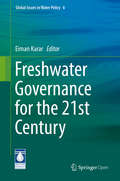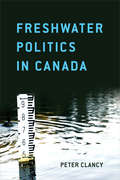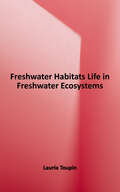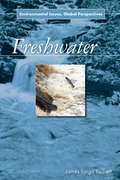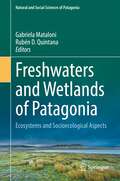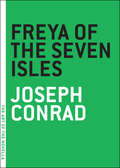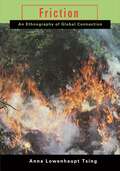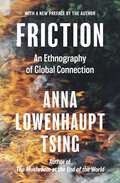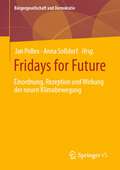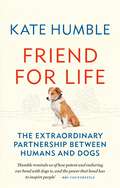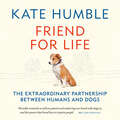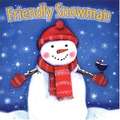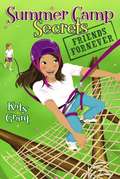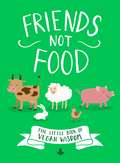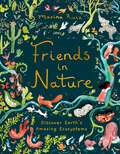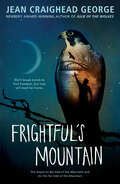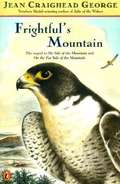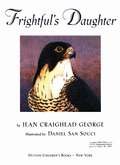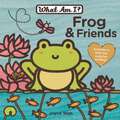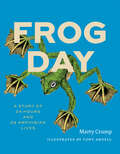- Table View
- List View
Freshwater Governance for the 21st Century
by Eiman KararThe objective of this book is to broadly illustrate the key aspects of water governance, mapping the spectrum of decision-making from techno-centric and eco-centric approaches, to hybrid concepts and people-centric approaches. Topics covered include the challenges for water-governance models, the polycentric model, the integration challenge, water in the decision-making hierarchy, and the rise of water-sensitive design, while also taking into account interdependencies between stakeholders, as well as the issue of scale. The book's content is presented in an integrated and comprehensive format, building on detailed case studies from around the world and the authors' working experiences in the water sector. Combining essential insights with accessible, non-technical language, it offers a valuable resource for academics, technicians and policy-makers alike.
Freshwater Politics in Canada
by Peter ClancyFreshwater is in great supply across much of Canada. However, competing and changing demands on its use are leading to ever more complex political arrangements. This volume offers an integrated survey of that complexity, combining historical and contemporary cases in a conceptually-informed exploration of water politics. It offers a set of tools, frameworks, and applications that enable readers to recognize and explore the political dimensions of freshwater. The opening chapters introduce core concepts such as power, organized interests, knowledge systems, and the state. They are followed by chapters discussing freshwater subsectors including fisheries, irrigation, flood control, hydropower, and groundwater. A series of topical themes is addressed, including salmon conservation, Aboriginal water interests, hydraulic fracturing, regulatory revisions, and interjurisdictional management. A final section explores emerging trends in freshwater governance. While river catchments are not always the principal denominator in discussions of water politics, they do provide a primary frame of reference for this book. A watershed case study accompanies each chapter. This watershed grounding is intended to encourage readers to turn their attention to local and regional conditions.
Freshwater habitats : life in freshwater ecosystems
by Laurie ToupinA look at the plants, animals, locations, and various habitats that make up the freshwater ecosystems of the world.
Freshwater: Environmental Issues, Global Perspectives
by James Fargo BalliettFreshwater is our planet’s most precious resource, and also the least conserved. Freshwater makes up only 3 percent of the total water on the planet, and yet the majority (1.9 percent) is held in a frozen state in glaciers, icebergs, and polar ice fields. This leaves approximately one-half of 1 percent of the total volume of water on the planet as freshwater available in liquid form. This book traces the complex history of the steady growth of humankind’s water consumption, which today reaches some 9.7 quadrillion gallons per year. Along with a larger population has come the need for more drinking water, larger farms requiring extensive irrigation, and more freshwater to support business and industry. At the same time, such developments have led to increased water pollution. Three detailed case studies are included. The first looks at massive water systems in locations such as New York City and the efforts required to protect and transport such resources. The second shows how growth has affected freshwater quality in the ecologically unique and geographically isolated Lake Baikal region of eastern Russia. The third examines the success story of the privatized freshwater system in Chile and consider how that country’s water sources are threatened by climate change.
Freshwaters and Wetlands of Patagonia: Ecosystems and Socioecological Aspects (Natural and Social Sciences of Patagonia)
by Gabriela Mataloni Rubén D. QuintanaThe Freshwaters of Patagonia adopts a socioecological approach, in which experts from across Patagonia review recent, scientifically rigorous literature and data of their own, thus synthesizing the current knowledge directly relevant to understand the present state and future trends of icefields, freshwater and wetland ecosystems in this region.The book’s organization into three parts provides a studied and comprehensive view on the patterns and processes of the various ecosystems in Patagonia, and describes the sociological aspects of freshwater ecosystems, as well as characterizes the conservation of the freshwater and wetland ecosystems, in Patagonia. The chapters offer a broad, state-of-the-art overview of the current status of glaciers, freshwater and wetland ecosystems of this region, as well as studies of both local and large scale biodiversity patterns, and study cases of extreme and naturally polluted environments.The volume concludes with the current status of Patagonian freshwaters, and discusses the scientific, legal and administrative tools aimed at their sustainable management within the framework of the UNEP Sustainable Development Goals 2030 Agenda. A broad audience of students, scientists, engineers, environmental managers, and policy makers will be interested in this volume.
Freya of the Seven Isles (The Art of the Novella)
by Joseph ConradThere is a degree of bliss too intense for elation.This little-known novella from one of the masters of the form is so unusual for Joseph Conrad's work in several respects, although not in its exotic maritime setting or its even more exotic prose--it is unusual in that it is one of his very few works to feature a woman as a leading character, and to take the form of a romance.Still, it's a Conradian romance: a sweeping saga set in the Indian Ocean basin, against a turbulent background of barely suppressed hostilities between Dutch and British merchant navies, told by one of Conrad's classically detached narrators. In the end, the unique perspective of the sharply etched character of Freya is one of Conrad's most piercing studies of how the lust for power can drive men to greatness--or its opposite. The Art of The Novella Series Too short to be a novel, too long to be a short story, the novella is generally unrecognized by academics and publishers. Nonetheless, it is a form beloved and practiced by literature's greatest writers. In the Art Of The Novella series, Melville House celebrates this renegade art form and its practitioners with titles that are, in many instances, presented in book form for the first time.
Friction: An Ethnography of Global Connection
by Anna Lowenhaupt TsingWhat the struggle over the Indonesian rainforests can teach us about the social frictions that shape the world around usRubbing two sticks together produces heat and light while one stick alone is just a stick. It is the friction that produces movement, action, and effect. Anthropologist Anna Lowenhaupt Tsing challenges the widespread view that globalization invariably signifies a clash of cultures, developing friction as a metaphor for the diverse and conflicting social interactions that make up our contemporary world.Tsing focuses on the rainforests of Indonesia, where in the 1980s and 1990s capitalist interests increasingly reshaped the landscape not so much through corporate design as through awkward chains of legal and illegal entrepreneurs that wrested the land from previous claimants, creating resources for distant markets. In response, environmental movements arose to defend the rainforests and the communities of people who live in them. Not confined to a village, province, or nation, the social drama of the Indonesian rainforests includes local and national environmentalists, international science, North American investors, advocates for Brazilian rubber tappers, United Nations funding agencies, mountaineers, village elders, and urban students—all drawn into unpredictable, messy misunderstandings, but misunderstandings that sometimes work out.Providing an invaluable portfolio of methods for the study of global interconnections, Friction shows how cultural differences are in the grip of worldly encounter and reveals how much is overlooked in contemporary theories of the global.
Friction: An Ethnography of Global Connection
by Anna Lowenhaupt TsingWhat the struggle over the Indonesian rainforests can teach us about the social frictions that shape the world around usRubbing two sticks together produces heat and light while one stick alone is just a stick. It is the friction that produces movement, action, and effect. Anthropologist Anna Lowenhaupt Tsing challenges the widespread view that globalization invariably signifies a clash of cultures, developing friction as a metaphor for the diverse and conflicting social interactions that make up our contemporary world.Tsing focuses on the rainforests of Indonesia, where in the 1980s and 1990s capitalist interests increasingly reshaped the landscape not so much through corporate design as through awkward chains of legal and illegal entrepreneurs that wrested the land from previous claimants, creating resources for distant markets. In response, environmental movements arose to defend the rainforests and the communities of people who live in them. Not confined to a village, province, or nation, the social drama of the Indonesian rainforests includes local and national environmentalists, international science, North American investors, advocates for Brazilian rubber tappers, United Nations funding agencies, mountaineers, village elders, and urban students—all drawn into unpredictable, messy misunderstandings, but misunderstandings that sometimes work out.Providing an invaluable portfolio of methods for the study of global interconnections, Friction shows how cultural differences are in the grip of worldly encounter and reveals how much is overlooked in contemporary theories of the global.
Fridays for Future: Einordnung, Rezeption und Wirkung der neuen Klimabewegung (Bürgergesellschaft und Demokratie)
by Anna Soßdorf Jan PollexDer Sammelband verfolgt das Ziel, eine erste umfassende Bilanz zur Rezeption und Wirkung der "Fridays for Future"-Bewegung vorzunehmen. Im ersten Teil stellen die Autor*innen in verschiedenen Kapiteln den Stand der sozialwissenschaftlichen Forschung zur Bewegung dar. Im zweiten Teil des Bandes widmen sich die Autor*innen den Wirkungen, die "Fridays for Future" auf unterschiedlichen Dimensionen der Gesellschaft hat. Die Beiträge in diesem Teil gehen der Frage nach, wie die Bewegung u.a. politische Parteien, lokale und regionale Akteure oder auch die Wissenschaft insgesamt beeinflusst hat, bzw. welche Impulse sie setzen konnte.
Friend for Life: The extraordinary partnership between humans and dogs
by Kate Humble'There is one animal that is familiar to all of us, whoever we are, wherever we live''Even if we've never had direct contact with one, we will have seen one, or at the very least, heard one. For those of us who live in the western world it is more than likely that one sleeps in our house, possibly even on our bed. I'm talking of course, of the dog. Yet, this animal, which lives alongside five hundred million of us all over the world - as an invaluable partner and a trusted confidant - presents us with one great unsolved mystery: how did this relationship - the most complex and enduring of any between human and animal - start in the first place?'Kate Humble is a life-long animal lover. Now living on an idyllic farm in Wales, she has achieved her dream of surrounding herself with as many varieties as possible. But, as with many Brits, the dog has always held a special place in her heart. Here, she uses her journey with her sheepdog puppy Teg to frame her examination of this very special relationship. Written with warmth and love, and packed full of stories about rescue dogs, guide dogs, service dogs and medical dogs, this is a must-read for anyone with a four-legged friend.
Friend for Life: The extraordinary partnership between humans and dogs
by Kate Humble'There is one animal that is familiar to all of us, whoever we are, wherever we live''Even if we've never had direct contact with one, we will have seen one, or at the very least, heard one. For those of us who live in the western world it is more than likely that one sleeps in our house, possibly even on our bed. I'm talking of course, of the dog. Yet, this animal, which lives alongside five hundred million of us all over the world - as an invaluable partner and a trusted confidant - presents us with one great unsolved mystery: how did this relationship - the most complex and enduring of any between human and animal - start in the first place?'Kate Humble is a life-long animal lover. Now living on an idyllic farm in Wales, she has achieved her dream of surrounding herself with as many varieties as possible. But, as with many Brits, the dog has always held a special place in her heart. Here, she uses her journey with her sheepdog puppy Teg to frame her examination of this very special relationship. Told with warmth and love, and packed full of stories about rescue dogs, guide dogs, service dogs and medical dogs, this is a must for anyone with a four-legged friend.
Friend for Life: The extraordinary partnership between humans and dogs (Kate Humble)
by Kate Humble'There is one animal that is familiar to all of us, whoever we are, wherever we live''Even if we've never had direct contact with one, we will have seen one, or at the very least, heard one. For those of us who live in the western world it is more than likely that one sleeps in our house, possibly even on our bed. I'm talking of course, of the dog. Yet, this animal, which lives alongside five hundred million of us all over the world - as an invaluable partner and a trusted confidant - presents us with one great unsolved mystery: how did this relationship - the most complex and enduring of any between human and animal - start in the first place?'Kate Humble is a life-long animal lover. Now living on an idyllic farm in Wales, she has achieved her dream of surrounding herself with as many varieties as possible. But, as with many Brits, the dog has always held a special place in her heart. Here, she uses her journey with her sheepdog puppy Teg to frame her examination of this very special relationship. Written with warmth and love, and packed full of stories about rescue dogs, guide dogs, service dogs and medical dogs, this is a must-read for anyone with a four-legged friend.
Friend for Life: The extraordinary partnership between humans and dogs (Kate Humble)
by Kate Humble'There is one animal that is familiar to all of us, whoever we are, wherever we live''Even if we've never had direct contact with one, we will have seen one, or at the very least, heard one. For those of us who live in the western world it is more than likely that one sleeps in our house, possibly even on our bed. I'm talking of course, of the dog. Yet, this animal, which lives alongside five hundred million of us all over the world - as an invaluable partner and a trusted confidant - presents us with one great unsolved mystery: how did this relationship - the most complex and enduring of any between human and animal - start in the first place?'Kate Humble is a life-long animal lover. Now living on an idyllic farm in Wales, she has achieved her dream of surrounding herself with as many varieties as possible. But, as with many Brits, the dog has always held a special place in her heart. Here, she uses her journey with her sheepdog puppy Teg to frame her examination of this very special relationship. Written with warmth and love, and packed full of stories about rescue dogs, guide dogs, service dogs and medical dogs, this is a must-read for anyone with a four-legged friend.
Friendly Snowman
by Catherine ShoolbredFor the littlest readers - a Christmas board book with a twinkly cover. In FRIENDLY SNOWMAN, it's cold outside, and snow is falling softly. Three rosy-cheeked children are building a snowman out of snow and twigs. And when they say goodbye to him, they're sure they see him wave! Picture descriptions present.
Friends Fornever (Summer Camp Secrets #3)
by Katy GrantDear _, I spent the last year counting down the seconds until I could come back to Camp Pine Haven and see my BFF Nicole. Every summer we have together at camp is better than the last! Well, except this year. I don't know what's up with Nic, but suddenly I can't say anything right. I thought she'd be happy for me that things at home have gotten better, but it almost seems like she's mad that my life is going so well. Am I losing my best friend? XO, Darcy
Friends From The Forest
by Joy AdamsonFrom the Book Jacket: Foreword by Juliette Huxley In these two animal studies we have a last, touching testimony of Joy Adamson's gift for eliciting trust from creatures of the wild. The home of her later years, Elsamere, is a bungalow set on large wooded grounds bordering on the remnants of wild forest. To Joy's delight, two fascinating sets of visitors settled near Elsamere: picturesque Colobus monkeys, with their marvelously expressive faces, and a family of Verreaux's eagle owls, the third largest owl in the world and the largest in Africa, with a wingspan of twenty-three inches.
Friends Not Food: The Little Book of Vegan Wisdom
by AnonymousChickens, Cows, Ducks, Sheep, Pigs, Rabbits, Trout, Salmon, Prawns, Lobsters - all of the animal kingdom - are not here for us to eat, we should be looking after them.Friends Not Food is a celebration of our relationship with our animal friends and is packed with vegan sayings as well as facts about both those animals and the industries that prey on them.The perfect gift for anyone who loves animals!And whilst you #StayHome, don't miss these other great titles from Sphere Books: ** Distract Yourself: 101 Positive Things to Do and Learn Whilst You Stay Home ** ** The Bumper Book of Would You Rather? Over 350 hilarious hypothetical questions for ages 6 to 106 **** Home Sweet Home: The Little Book of Natural Cleaning **** Shelf Respect: A Book Lovers' Guide to Curating Book Shelves at Home **
Friends Not Food: The Little Book of Vegan Wisdom
by AnonymousChickens, Cows, Ducks, Sheep, Pigs, Rabbits, Trout, Salmon, Prawns, Lobsters - all of the animal kingdom - are not here for us to eat, we should be looking after them.Friends Not Food is a celebration of our relationship with our animal friends and is packed with vegan sayings as well as facts about both those animals and the industries that prey on them.The perfect gift for anyone who loves animals!And whilst you #StayHome, don't miss these other great titles from Sphere Books: ** Distract Yourself: 101 Positive Things to Do and Learn Whilst You Stay Home **** The Bumper Book of Would You Rather? Over 350 hilarious hypothetical questions for ages 6 to 106 **** Home Sweet Home: The Little Book of Natural Cleaning **** Shelf Respect: A Book Lovers' Guide to Curating Book Shelves at Home **
Friends in Nature: Discover Earth's Amazing Ecosystems
by Marina RuizDiscover the incredible ways in which animals and plants help each other, the planet and YOU to thrive with this illustrated tale of symbiosis and ecology for children aged 5-7.Can you imagine a world where you had to do everything by yourself? It's pretty impossible. The truth is, everyone needs a little help from someone, or something.All living things in the natural world - from the trees and the bees to the dogs and the frogs - depend on one another. There wouldn't be a coral reef without the help of all the fish that have made it their home. Rainforests are only filled with lush and colourful plants because of the birds and mammals who eat and scatter their seeds. Acacia trees have a whole army of ants to protect them, while elephants rely on egrets to keep them parasite-free. And it's because of bees, wasps and butterflies that we have tasty fruit and vegetables to eat.Created by writer and artist Marina Ruiz, beautifully illustrated scenes reveal the wonderful connections and cooperation in nature. Narrative storytelling links every spread to the next, exploring how even the tiniest relationship has a big impact in keeping our planet's huge and complex web balanced.
Friends of the Earth: A History of American Environmentalism with 21 Activities (For Kids series #42)
by Pat MccarthyThe history of American environmentalism is the history of men and women who dedicated their lives to protecting the nation's natural heritage. Almost singlehandedly, John James Audubon introduced the study of birds in North America. John Muir pushed a president and a nation into setting aside vast preserves, including Yosemite, Sequoia, Mt. Rainier, and the Grand Canyon. Marjory Stoneman Douglas did the same for the Florida Everglades, as did Mardy Murie with the Grand Tetons and the Arctic National Wildlife Refuge. Cordelia Stanwood, and later Roger Peterson, revolutionized and popularized birdwatching. Rachel Carson opened the world's eyes to the dangers of pesticides, and Julia "Butterfly" Hill saved a 1,000-year-old redwood while bringing to light the devastation of our old growth forests. Together, these environmentalists' inspiring life stories tell the story of American environmentalism, from its inception to the present day. In Friends of Our Earth readers will also learn how to put their concerns into action. Author Pat McCarthy gives step-by-step instructions on how to build a birdfeeder, conduct a water quality survey, start a compost pile, study the Greenhouse Effect, make plaster casts of animals tracks, create their own recycled paper, test for acid rain, and more. It includes a time line of historic milestones, popular outdoor parks and sites to visit or explore online, and Web resources for further study.
Frightful's Mountain
by Jean Craighead GeorgeFrightful, the pelegrine falcon, could not see. A falconer's hood covered her head and eyes. She remained quiet and clam, like all daytime birds in the dark. She would hear, however. She listened t the wind whistling through the pine needles. The wind-music conjured up images of a strange woods and unknown flowers. The sound was foreign. It was not the soft song of wind humming through the hemlock needles of home. Frightful was a long way from her familiar forest. Suddenly an all-invading passion filled her. She must go. She must find one mountain among thousands, one hemlock tree among millions,. And the one boy who called himself Sam Gribley. The one mountain was her territory, the one tree was Sam's house, the perch beside it, her place. And Sam Gribley was life.So begins the third book in the wilderness series that has lifted imaginations around the worlds. Readers last head from Sam Gribley a decade ago , when he kept the hardest resolution of his life and let his falcon partner go free. Now at last we pick up the sotry?but this time, the narrative continues through Frightful's keen-sighted eyes.Raised by Sam, Frightful is an imprinted bird. She has no idea how to migrate, mate, or be a mother. She can barely even feed herself, for although she is a skilled hunter, it was always Sam who signaled permission to partake of the kill. Sam, so patient and kind, will support her from afar, and so will bird activists Jon and Susan wood and conservationist Leon Longbridge. But despite a letter-writing campaign by local schoolchildren, other would despoil her Catskill home?designing fatal electrical wires and disturbing good nesting areas with jackhammers and paint trucks.With evolution and a proud natural intelligence on her side, Frightful may yet beat the odds of famine, winter, and human encroachment. But her terrible longing for that one mountain among thousands, her first home?a longing so noble and generous yet so dangerous?will govern her to either heartbreaking failure or hart-aching triumph, a triumph so right and so natural that readers will want to take to the skies in celebration.Jean Craighead George published My Side of the mountain in 1959, a Newbery Honor Book and coming-of-age story that has enthralled and entertained generations of would-be Sams. This third book in the series shares?in exquisite, elegantly flowing prose?Frightful's own passage into adulthood, taking readers on a journey into the mind and spirit of one of the wild's most magnificent creations and proving once again why the author is considered the most gifted nature writer of her time.
Frightful's Mountain (My Side of the Mountain #3)
by Jean Craighead GeorgeAs she grows through the first years of her life in the Catskill Mountains of New York, a peregrine falcon called Frightful interacts with various humans, including the boy who raised her, a falconer who rescues her, and several unscrupulous poachers, as well as with many animals that are part of the area's ecological balance.
Frightful‘s daughter
by Jean Craighead GeorgeSam brings Oksi, a peregrine falcon, home after a thief steals Oksi’s brothers from their nest.
Frog & Friends
by Joyce WanI swim with the fish, hop with the frogs, and paddle with the ducks. What am I? Children are asked to figure out just who does all these things in this delightful, bright book. A beautiful spread at the end reveals it&’s a lovely pond.
Frog Day: A Story of 24 Hours and 24 Amphibian Lives (Earth Day)
by Marty CrumpAn illustrated hourly guide that follows twenty-four frogs as they eat, find mates, care for their young, and survive our harsh and changing planet. In this short book, celebrated biologist Marty Crump leads readers on a worldwide field trip in search of frogs. Each chapter of Frog Day covers a single frog during a single hour, highlighting how twenty-four different species spend their time. Our day begins at midnight in Indonesia, with the rustle of leaves above. It’s not a bird, but Wallace’s flying frog, using its webbed feet and emerald-green skin flaps to glide through the forest canopy. In the early hours of the morning, we hear a horned marsupial frog “bopping” and a wood frog “quacking” to attract mates. At six o’clock in the morning, beneath a streetlight in Honolulu, we meet a corpulent, invasive cane toad slurping insects—and sometimes snakes, lizards, turtles, birds, and mice. At noon, we watch parenting in action as an African bullfrog bulldozes a path through the mud to free his tadpoles from a drying pond. At dusk, in a Peruvian rain forest, we observe “the ultimate odd couple”—a hairy tarantula and what looks like a tiny amphibian pet taking shelter in the spider’s burrow. Other frogs make a tasty meal for this tarantula, but the dotted humming frog is a friend, eating the ants that might otherwise make a meal of the tarantula’s eggs. For each hour in our Frog Day, award-winning artist Tony Angell has depicted these scenes with his signature pen and ink illustrations. Working closely together to narrate and illustrate these unique moments in time, Crump and Angell have created an engaging read that is a perfect way to spend an hour or two—and a true gift for readers, amateur scientists, and all frog fans.
